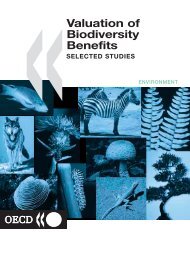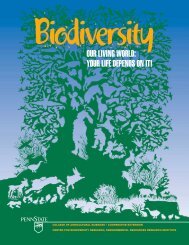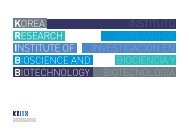Untitled
Untitled
Untitled
- No tags were found...
Create successful ePaper yourself
Turn your PDF publications into a flip-book with our unique Google optimized e-Paper software.
OUTSTANDINGRESEARCH ACHIEVEMENTS9. IDENTIFIED LIFE EXTENSION AND AGING CONTROL OF CURCUMINResearcher Dr. Kweon Yu I July 2010Drosophila is used to prove that curcumin suppresses aging and reduces expression of genes thataccelerate aging. Vinegar flies that ate curcumin lived 20% longer on an average than the controlgroup, and exhibited greater health life as aging-retrogression was reduced. It was found that thefirst fly group has more resistance to various environmental stresses than their control group, andthe group extended their lives by changing the expression of aging-related genes.13. SIGNIFICANTLY IMPROVED THE PRECISION FOR CALCULATION OF GENEDOSAGEResearcher Dr. Sanghyuk Lee I November 2010A new analysis technique, called NEUMA (Normalization by Expected Uniquely Mappable Area),was developed. The newly developed technology greatly improved the precision when calculatinggene dosage from mass sequence data which was generated from the Next Generation Sequencing(NGS) method. In a bid to overcome the limitations that the existing Cufflinks or TopHat methodshave, NEUMA measured gene dosage using the already known RAN information. It is a state-ofthe-arttechnology that significantly improved the precision of the gene dosage measurement fromNGS data that are generated in a massive volume. It is also a core technique that can advance anera of future medicine that is based on personal genome information.10. DEVELOPED POPLAR IMMUNE TO ENVIRONMENTAL STRESSResearcher Dr. Sang-Soo Kwak I September 2010Eco-friendly trait-converting poplar, which is immune to environmental stresses and can grow indomestic and overseas areas with unfriendly condition for growing, was developed. The SN poplarthat converts trait showed tolerance to oxidative stress in the LMO ∆˜¿Â proliferation process bythe Korea Forest Research Institute. On top of this, it exhibited the effect of accelerating growthand development by facilitating activation of auxin synthetic gene, a plant growth hormone. It isexpected to allow obtainment of Certified Emission Reduction and purification of soil in the pollutedareas through increased biomass when planting them in areas with unfriendly condition forgrowing in Korea and overseas, such as desertification area, polluted area, etc in the future.14. BEAN LEAF EXTRACTS FOUND TO BE EFFECTIVE IN FIGHTING OBESITY ANDIMPROVING BLOOD CIRCULATIONResearcher Dr. Tae-Sook Jeong I December 2010The research team has completed application for patents in Korea and overseas for compound forprevention and treatment of metabolic syndrome (including obesity, hyperlipidemia,atherosclerosis, and diabetes) of bean leaves and bioactive materials extracted from bean leaves.The team imported model animals for arteriosclerosis (LDLR-/- mouse) and ran a test for twelveweeks. As a result, animals in which bean leaf extracts were injected (1% of content weight amongfeed) showed a signification reduction of accumulation of lesion in the aorta and of sticking ofmacrophage, a major factor that causes arteriosclerosis. Also, it exhibited less accumulation of fatin the liver tissue and liver cell, which was resulted in prevention of arteriosclerosis and a fatty liver.11. SUPPRESSED PROLIFERATION OF CANCER CELL WHEN REDUCINGEXPRESSION OF “ENIGMA”Researcher Dr. Dong-Soo Im, Cho-Rok Jung I November 2010It was first discovered that enigma, one of the proteins in the cell, influences the proliferation ofcancer cells, results in increasing resistance to anticancer medicines. The research team foundthat enigma and Mdm2 in the liver and stomach cancer tissues exist at the same location in thecancer cell, and that the more enigma and Mdm2 exist, the less p53 becomes. For cancer cellsthat have more expressed enigmas, cancer continuously proliferates even when administeringAdriamycin, an anticancer medicine. However, the team proved, in a mice tumor model, thatblocking the expression of enigma significantly reduced the proliferation of cancer cell.15. DEVELOPED MATERIALS TO PREVENT RED COLORING AND ROOT ROT OFGINSENG AND BIOACTIVE MATERIALSResearcher Dr. Young-Kook Kim I December 2010A research team found bioactive materials and prevention materials against red coloring and rootrot of ginseng, which have been the cause of reducing their product value. The team developed B-4228, a new strain of bacillus subtilis, which impedes growth and development of trichodermaviride and production of red pigment by penicillium purpurogenum, which causes of red coloring ofginseng, along with a red-coloring prevention compound that contains the new strain.12. DEVELOPED CORE TECHNIQUE FOR THE NEXT-GENERATION ANTIBIOTIC BYDECODING GENOME OF USEFUL MICROBEResearcher Dr. Seung-Hwan Park I November 2010“Polymyxin,” a biosynthetic genome, was identified for the first time in the world through a genomefunction study of “Paenibacillus polymyxa,” a germ useful to plants. Along with this, the researchteam laid a core foundation for development of agricultural materials, such as eco-friendly microbepesticide and fertilizer, as it secures many genes, which facilitate growth and development ofplants, and control pathogenic bacterium harming plants from the same germ.The team discovered genetic information that synthesizes polymyxin biosynthesis enzyme frompaenibacillus genome, and successfully produced a trait converting body of bacillus subtilis, whichproduces polymyxin, using synthetic biology technology. This helped the team to establish thefoundation for effective development and production of new antibiotics, while obtaining US patentfor the related techniques.114 KRIBB Annual Report 2010KRIBB Annual Report 2010 115












